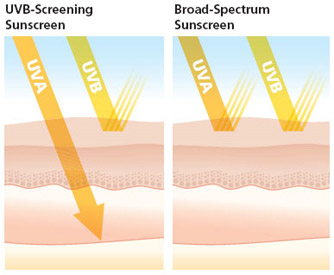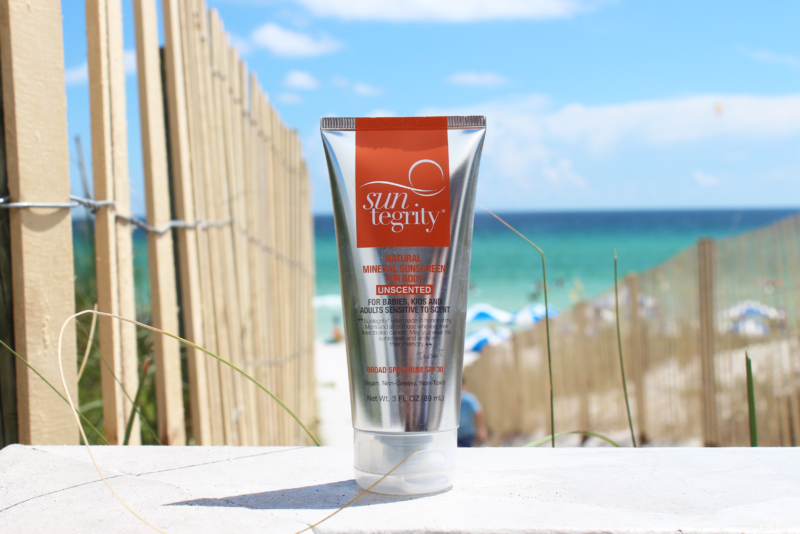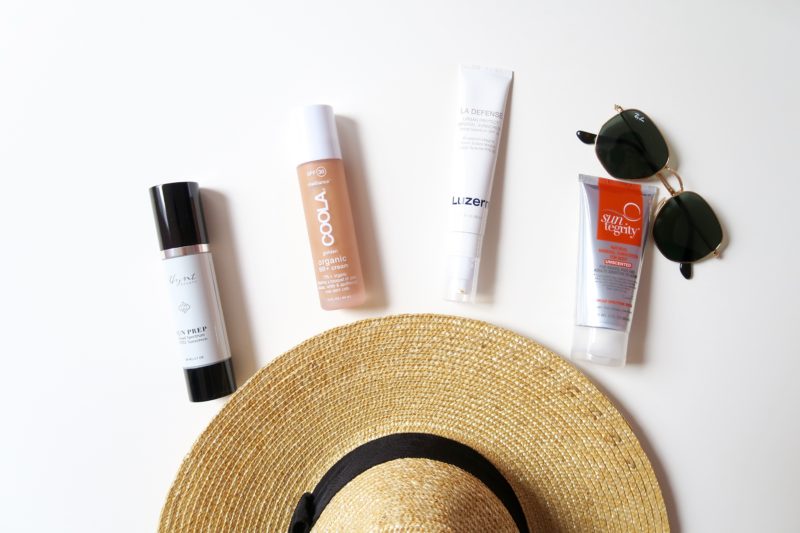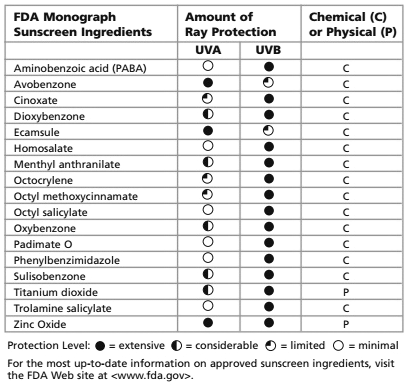I thought that this time of the year would be perfect to talk about the sunscreen products that made it to my list of repurchases. That’s a narrow list because I have had a problematic relationship with face sunscreen for years. I can’t stand the feeling of a tacky, greasy, pasty-looking layer of bizarre-smelling lotion on my face. I am also a recovering sun worshiper. I spent most of my life enjoying the sun carelessly.
It’s finally Spring–at least in this side of the globe—though it hasn’t been feeling that way in some places (even here in Florida evenings have been more chilly than usual). I know that some of you will go on vacation, head to festivals, or just spend more time outdoors. So I wanted to give you not only my product recommendations, but also share with you what I look for in sunscreen products. I want to share which key facts I keep in mind, which labeling claims are important/totally worthless, and which ingredients I want/avoid and why.
When to Start Sun Protection
Before talking about products, I want to touch on some important basic info about sun protection. This is a topic that is very dear to my heart because, 1) I lost my dear uncle to melanoma, a skin cancer, and 2) I have experienced a lot of sun damage on my face due to my irresponsible exposure to the sun in my teens and twenties (sunspots, discoloration, textural changes, etc). All things that I cannot reverse completely, and cannot improve significantly without expensive treatments.
I hope that this information is going to help you to prevent making the same mistake, or at least prevent further damage. It’s never too late to start taking good care of your skin. Also keep in mind that it is estimated that sun damage accounts for 80% of skin’s premature aging, including wrinkles, sagging and sunspots. No matter how well you take care of your skin with diet, lotions, and potions, if you don’t protect it from the sun, you are doing your skin (and your wallet) great disservice.
Sun Rays: Are They Really Harmful?
There are three main types of UV rays (in which UV stands for ultraviolet radiation): UVA, UVB, and UVC. We don’t need to worry about UVCs because they don’t reach the earth and do not cause any damage to the skin, but we need to protect our skin from both UVAs and UVBs. Both types of rays can cause cellular damage and oxidative stress.
UVAs are the ones that reach our skin all year long–no matter the weather–because they can penetrate clouds. These are the rays that cause damage to the deepest layers of our skin (called dermis) and cause photoaging. They destroy collagen and elastin, leading to wrinkling and sagging.
UVBs are the rays that cause damage in the most superficial layer of our skin. They cause the reddening of our skin–the sun-tan/sun-burnt look. “Tan” is basically a nice way to describe a sunburn.
UVBs are thought to be responsible for skin cancers. According to the Skin Cancer Foundation and the American Academy of Dermatology, using sunscreen can reduce the risk of non-melanoma cancers by 40 percent and melanoma by 50 percent.
Broad Protection/Full-Spectrum
In light of the type of damage that these rays can cause, the first thing that I look for in a sunscreen is broad-spectrum protection. When a sunscreen is labeled as broad-spectrum, it means that it has passed an FDA-regulated test that proves that the product protects the skin from both UVAs and UVBs. Keep in mind that the active ingredients that are known to filter UVAs are avobenzone (in chemical sunscreens), zinc oxide (in physical sunscreens) and titanium dioxide (in physical sunscreens), which is considered slightly less effective than zinc oxide.

Chemical Vs. Physical Sunscreen
There are three main categories of sunscreen products that can protect the skin from UV damage—chemical sunscreens, physical sunscreens, and a combination of the two. Chemical and physical sunscreens work in different ways, so it’s important to understand the difference in order to make the best choice for your skin.
Chemical
Chemical sunscreens contain carbon-based compounds that absorb the UV rays when they reach the skin, change them into heat, and then release them. They are also called “organic” sunscreens due to the active ingredients being carbon-based, (keep that in mind, because if you search for “organic” sunscreens, your search will lead to chemical sunscreens). They have the benefit of being virtually weightless in texture and cosmetically pleasing—easy to spread, blend, and clear.
Unfortunately, the active ingredients in chemical sunscreens tend to be very irritating and potentially (likely) sensitizing. This means that your skin can become more sensitive to a certain chemical filter as you keep using it, until it starts triggering a reaction. For my skin, the ones I tried have been a total nightmare, causing a lot of redness and stinging. The fact that they cause the skin to heat up (because they absorb the UV rays and “transform” them into heat) can also cause problems for people who suffer from inflammatory skin conditions like rosacea and acne. Chemical filters also present the problem of breaking down in the sun, because the active ingredients are typically unstable.
In addition to that, some of the active ingredients in chemical sunscreens have presented some safety concerns. Some of these compounds are thought to cause harmful effects on the body, such as disrupting hormones. Therefore, if you currently use a sunscreen product that contains oxybenzone, octocrylene, octinoxate, homosalate, or octyl methoxycinnamate, I would highly encourage you to consider an alternative, as these seem to be the most concerning ingredients.
Lastly, if you have sun spots, keep in mind that the heat caused by chemical sunscreens in your skin may worsen/increase brown spots. Chemical sunscreens are the ones that you need to apply 20 minutes prior to sun exposure and re-apply frequently. They tend to degrade with time, so make sure to check the PAO (period after opening) date and the expiration date.
Physical/Mineral/Sunblock
Physical sunscreens are also called mineral sunscreens or sunblock. The reason behind their name is that the mineral active ingredients deflect the UV rays, forming a physical barrier that does not allow the UV rays to penetrate into the skin, which is why they are also called sunblock. The active ingredients used in these type of sunscreens are usually zinc oxide, titanium dioxide, or a combination of the two. While I often use products that contain titanium dioxide, my number 1 choice for sun protection are products that contain zinc oxide as their only active ingredients, preferably in a concentration of 18-20%.
The biggest problem with physical sunscreen and the reason why so many people choose chemical instead is that physical sunscreens tend to have a chalky, paste-like texture and leave an aesthetically unpleasing white cast on the skin. This is especially problematic for people with deeper skin tones.
Some companies try to make the texture more comfortable and easy to apply by adding ingredients like dimethicone, which helps the minerals not to clump together over time. Although I am not fond of silicones in skincare, I am okay with using them in sunscreens, due to the consistency issues.
Other brands offer tinted mineral sunscreens, where the tint is meant to disguise the whitening effect.
Here’s a list of FDA-approved sunscreen active ingredients, and how they perform:
SPF Rating: How Much SPF Is Really Enough?
SPF(sun protection factor), measures the sunscreen’s ability to prevent sun damage from UVB rays. This is a slightly difficult topic because, as the scientific research advances and new things are learned about how UV rays affect the skin, regulations are revised and new active ingredients are proposed. It’s good to stay up to date with what is recommended.
The simplest way to explain the most up-to-date (Spring ’18) SPF ratings are below:
-
- SPF 15 filters about 93% of UVB rays
-
- SPF 30 filters 97%
-
- SPF 50 filters 98%
- Sunscreens with SPF above 50 do not offer significantly more protection than SPF 50 (about 98.5 %), so don’t let marketing tricks get you.
Here is another way to explain SPF ratings: if it takes 10 minutes for your skin to burn in the sun, with an SPF 15 sunscreen it will take 15 times longer for your skin to burn (so 10 times 15 = 150 minutes) and with an SPF 30 sunscreen it will take 30 times longer, etc. That being said, no matter what the SPF rating of a sunscreen is, it should be re-applied throughout the day, as often as indicated on the product label, which is typically every two hours.
How Much Sunscreen You Should Apply
According to research, most people need approximately a nickel-sized amount of sunscreen for face and neck.
How Often You Should Replace Your Sunscreen
Sunscreen should be replaced as often as every year as they degrade and lose effectiveness. Always check your sunscreen’s label and set a reminder for yourself. I apply a sticky label with a date when I open a new sunscreen so I know when it’s time to toss it away (I would most definitely forget otherwise…).
Nano-sized, Mineral Particles: The Good, The Bad, & The Ugly
The reason why most mineral sunscreens leave a ghostly white cast on the skin is the size of the particles. In recent years, cosmetic chemists have begun to experiment with much, much smaller mineral particles that make the final product go on smoother and look less chalky. These really tiny particles are called nanoparticles.
The good news is that the smaller the mineral particles, the higher the SPF.
The bad news is that the smaller the particles, the worst the UVA protection.
Nanoparticles are so small that are thought to be potentially harmful when in personal care products. The fear is that they could penetrate the skin and enter the bloodstream. Although not much research has been done, the evidence available shows that nano-sized zinc oxide does not penetrate the skin and does not pose a risk to humans’ health.
The ugly news is that nearly all sunscreens contain nano-sized mineral particles, including products that are labeled as “non-nano”. This is–apparently–not a problem with topical sunscreen because as I mentioned, the evidence available suggests that there isn’t much to worry about with topical application. However, there is a significant concern for powder sunscreens and spray sunscreens because when nanoparticles are inhaled, they can damage respiratory organs such as lungs. You can read more about nanoparticles in sunscreens here.
Other Ingredients to Look For
Lastly, I highly recommend looking for mineral sunscreen products that containing beneficial ingredients–especially antioxidant-rich ingredients. According to research, antioxidants complement the effects of sunscreen in combating the formation of UVA-induced free radicals. In particular, look for vitamin C, vitamin E, and green tea.
Fragrance in Sunscreen
This is my personal advice to people with “sensitive” skin. If your skin gets irritated easily, make sure that your sunscreen is fragrance-free. Fragrances are typically irritating and sensitizing, and when exposed to the sun they can be even harsher and increase your skin’s vulnerability to sun damage.
My Favorite Sunscreens
For years, I have been looking for a face sunscreen that would not make feel the urge to scratch my face the moment I put it on. Finally, I have found a few products that I feel comfortable using and have helped me to wear face sunscreen all-year-long. These are the best mineral sunscreens that I have tried, and the only ones I have repurchased and can wholeheartedly recommend. Scroll to the end for body sunscreen recommendations as well.
Pros:
- broad-spectrum
- 20% zinc oxide
- slightly dewy finish
- best for normal to dry skin types, including mature
- fragrance-free!
- contains antioxidant-rich ingredients such as green tea and astaxanthin, moisturizing jojoba oil, and hydrating hyaluronic acid
- excellent packaging–airless pump tube
Cons:
- limited shade range (I am in between Light and Golden Light)
- pricey
My experience: I rivisited this product recently. When I first tried it years ago, the finish didn’t work for me. Going back to it now that my skin is drier and that I don’t live in a sub-tropical climate anymore, it feels just right–moisturizing without being heavy. It does not provide as much coverage as Impeccable Skin, but it’s enough for me to skip foundation altogether. It doesn’t settle in my lines as much as Impeccable Skin, too, because the consistency is a bit thinner.
Shop it here
☀️☀️☀️☀️☀️☀️
Pros:
- lightweight, lotion-like texture
- broad-spectrum
- SPF 25 from micronized zinc oxide (no titanium dioxide)
- sheer tint–not highly pigmented (doesn’t look like a mask)
- non-greasy & non-dewy
- good under makeup
- contains beneficial ingredients, such as: Niacinamide (which can help to reduce pigmentation), Squalane (my favorite face oil–emollient, non-irritating, UV protectant), Astaxanthin (most powerful antioxidant–more than Vitamin C!), and more. Seriously, so many beneficial botanical ingredients for a sunscreen!
- provides enough moisture for normal to oily skin types (you may be able to skip moisturizer altogether and just wear this)
Cons:
- tinted, so it may not be for you if you prefer a clear one
- if you have very fair skin you need to blend it on your neck or it will look like a different color from your face
- although it is called sunscreen + moisturizer, it may not substitute a moisturizer if you have dry skin (however you can layer it over a rich moisturizer/cream)
- packaging may be a bit tricky to use at first
My experience: this is, hands down, the most comfortable mineral face sunscreen I have ever tried. It does not feel greasy, itchy, oily, or clumpy. It’s so lightweight that it feels like I am not wearing sunscreen. This is the sunscreen I recommend to anyone living in a humid climate whose skin is more on the oily side. It is an answer to our prayers for sure. The packaging is a little bit tricky, so if you dispense it carelessly it can spritz too far and make messes. However, I find that if I direct the dispenser towards the closed palm of my hand, it doesn’t cause any issues. Lastly, take your time applying it! It may feel like it’s not settling on the skin at first, but once it does, it is SO comfortable and makes it worth it.
Shop it here
☀️☀️☀️☀️☀️☀️
Pros:
- lightweight, virtually weightless, mousse-like consistency
- broad-spectrum
- SPF 25
- clear (!!) no white cast at all
- sturdy packaging with a pump (no leakage issues)
- perfect under makeup
- beneficial ingredients like aloe, squalane, green tea, comfrey root, licorice root, and more!
- great for all skin types, including oily skin (won’t make you look greasy)
Cons:
- subtle scent (not added fragrance, but the ingredients give it a light scent)
- more expensive than my other sunscreens
My experience: do not let the white color of this sunscreen trick you–this is the sunscreen for people who hate sunscreen. It goes on clear and does not leave any greasy film on the skin. It’s perfect under makeup as a primer & sunscreen in 1.
Shop it here
☀️☀️☀️☀️☀️☀️
Pros:
- broad-spectrum
- 15% zinc oxide
- SPF 30
- blue light protection
- vegan
- oil & silicone-free
- velvety finish. Despite being marketed as “matte”, it has a luminous finish
- best for normal to oily skin types
- fragrance-free!
Cons:
- limited shade range
- oxidizes slightly (gets a hint darker 30 min after application)
- pricey
My experience: I have been using this sunscreen as my daily moisturizer+sunscreen+foundation in 1. It has a light-to-medium coverage (it disguises redness around my nose surprisingly well), and a luminous, but non-dewy, velvety finish. It’s my favorite face sunscreen by Suntegrity, and I would recommend to anyone who wanted to love the 5 in 1 but found it to be too heavy/oily. I use the shade Sand (compares to the 5 in 1 Tinted Sunscreen in the shade Golden Light).
Shop it here
☀️☀️☀️☀️☀️☀️
Pros:
- broad-spectrum
- 20% zinc oxide (solid protection!)
- SPF 50
- stick format is super convenient–no leaking, spilling, waste and small enough to carry in a small purse
- golden tint and no whitening cast at all
- long-lasting (it sticks to the skin well)
- offers some coverage–I use it in place of foundation
- does not “sweat off” the skin
- water resistant for 80 minutes
- beneficial ingredients like Tamanu seed oil, Avocado oil, Raspberry seed oil
Cons:
- only suitable for medium golden skin tones (though a non-tinted version is available here — I haven’t tried yet, so I can’t review it)
- though it’s a stick, I feel like it pulls the skin a bit if I try to apply straight to the face so I use my finger
- it feels a bit tacky. It’s not uncomfortable but your hair may get stuck to your face on a windy beach day
My experience: This sunscreen stick is my favorite for any outdoor activity like a beach day, jogging, gardening, etc. but I have also worn it for running errands. It’s the only face sunscreen I have tried that does not have any pink tone to it (most sunscreens, even those that are labeled as suitable for medium golden skin tones, tend to look pink on me). If you have fair skin, this will look too dark/orange on you. If you follow me on Instagram, check out my highlighted stories to see what it looks like on me.
Shop it here
☀️☀️☀️☀️☀️☀️
Pros:
-
- broad-spectrum
-
- combo Titanium Dioxide 3.2% + Zinc Oxide 1.8%.
-
- SPF 30
-
- it’s almost clear, no coverage (almost completely white cast-free on lighter skin tones)
-
- comfortable and lightweight
-
- matte finish (very matte)
-
- non-greasy, great for oily skin
-
- smooth and silky texture
-
- unscented
- beneficial ingredients like Cucumber
Cons:
-
- sheer coverage (the name tint may be misleading)
-
- may leave a white cast on deeper skin tones
- product tends to separate in the tube; shake well before the application
My experience: This is one of my all-time favorite face sunscreens to wear under makeup. Best for Summer when I am a bit more oily since it has a matte finish. One of the best mineral sunscreens I have tried.
Shop it here
☀️☀️☀️☀️☀️☀️
Pros:
- broad-spectrum
- SPF 30
- hydrating (hyaluronic acid)
- contains squalane and rosehip oils (two of the best oils for the skin)
- lightweight lotion texture
- all skin types
- sheer tint–no white cast
- luminous, non-greasy finish
- packed with skin-beneficial plant extracts
- additional sun-protective properties from antioxidant-rich ingredients
- no added fragrance (though it has a light floral scent)
Cons:
- pricey (justified by the ingredients, but still pricey)
- light floral scent may not be everyone’s cup of tea
- not suited for exercise, it melts off completely
My experience: In my humble opinion, this is a phenomenal skincare product and face sunscreen at the same time. You can’t just call it a face sunscreen because it contains more beneficial ingredients than your average face serum. This is the reason why, even though it is significantly more expensive than every face sunscreen I have tried, I can’t say it’s overpriced. I often apply it to bare skin as my only skincare product after cleansing and applying a toner. During hot/humid days, I find that it provides enough moisture for my skin. Work well under makeup as well. The only occasion that I would not recommend it for is for gym/exercise because I find that it melts off the skin quickly during a high intensity sweat sesh.
Shop it here
☀️☀️☀️☀️☀️☀️
Pros:
- broad-spectrum
- SPF 30
- hydrating
- “fresh skin”, dewy finish
- great for normal to dry skin
- blurs imperfections
- smells like rose, but delicate, not overpowering
Cons:
- the golden shade looks a bit pink on me
- though it’s called BB cream, it offers sheer coverage
- only 3 shades available, but it’s very sheer so you may find a decent match
- not for very oily skin
Shop it here
☀️☀️☀️☀️☀️☀️
Pros:
- ☀️☀️☀️☀️☀️☀️works well under makeup
- contains lutein, to protect the skin from blue light (computer/phone screens)
- several beneficial, antioxidant-rich ingredients, such as vitamin C and E, green tea, ginger, licorice (great to combat brown spots), hyaluronic acid, and more
Cons:
- leaves a slight white cast if I apply a thick layer
- lightly fragranced
My experience: I love this sunscreen under makeup, as a daily base. Please note that this is delicately fragranced, so if you are very sensitive, it may not be for you. I can wear it with no issues. Next, I want to try the Luzern La Defense Urban Protect BB Creme SPF20.
Shop it here
☀️☀️☀️☀️☀️☀️
Pros:
- 20% zinc oxide
- fragrance-free
- okay under makeup
- non-greasy
- you can buy it at Whole Foods!
- antioxidant ingredients
- most affordable among my favorites
Cons:
- leaves a slight white cast if I apply a thick layer
- not the best for dry skin
Shop it here
☀️☀️☀️☀️☀️☀️
- W3LL People Bio Tint Multi Action Moistuirizer SPF 30
Pros:
- lightweight, comfortable texture
- sheer but it evens out the skin tone nicely
- luminous non-greasy finish
- suitable for all skin types
Cons:
- limited shade range
My experience: At $28.99 this BB Cream is a phenomenal multi-tasking product…as long as you find a good match. I am somewhere between shades Light and Medium, but none of them is an exact match.
Shop it here
☀️☀️☀️☀️☀️☀️
Pros:
- broad-spectrum
- SPF 30
- 20% non-nano zinc oxide
- Golden Light shade is a good match for my skin tone
- great for dry and mature skin
- moisturizing
- beneficial ingredients like aloe, jojoba, cucumber, astaxanthin, hyaluronic acid and green tea
Cons:
- a bit greasy for normal/oily skin
Shop it here
☀️☀️☀️☀️☀️☀️
My Favorite Body Sunscreen
Pros:
- broad spectrum
- unscented
Cons:
- a bit greasy
- white cast
My experience: this has been my go-to body sunscreen for a few years. It offers solid protection and has kept me burn-free on long, sunny beach days.




